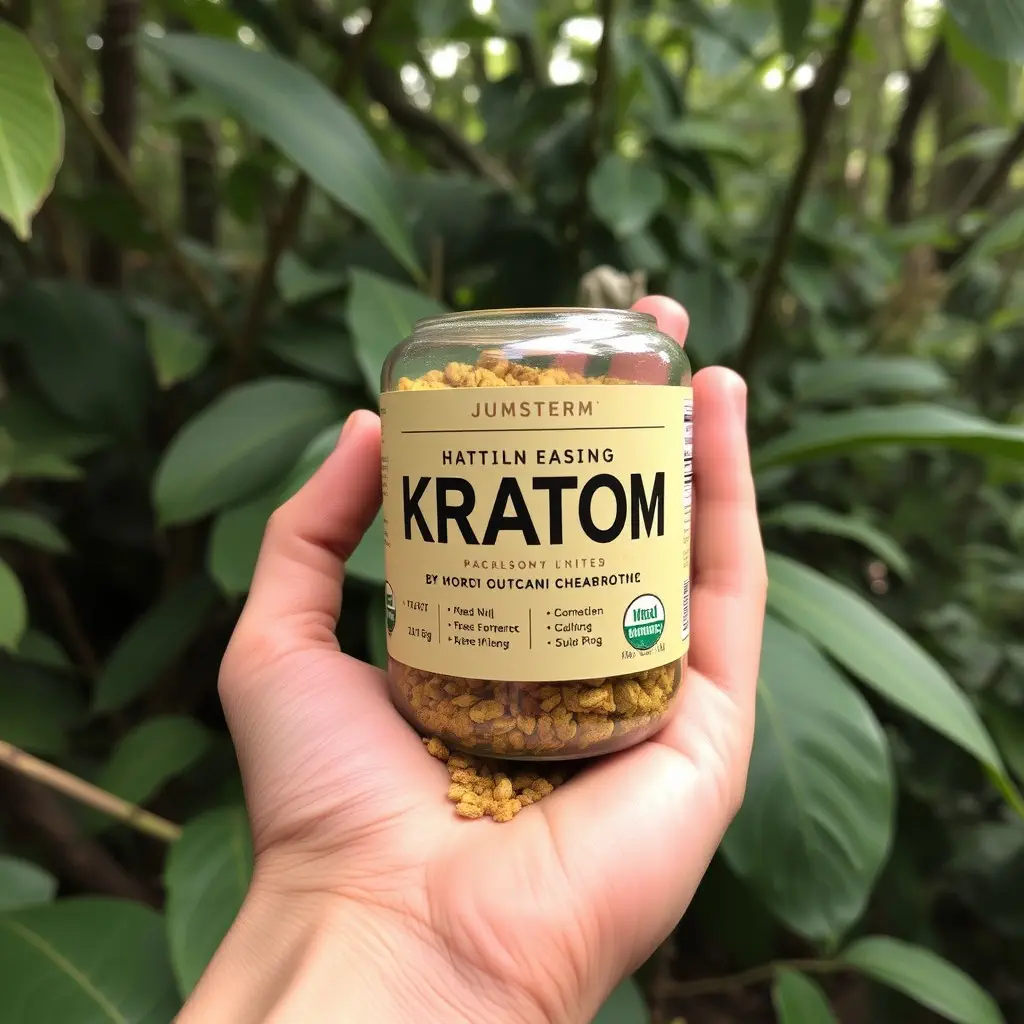Kratom, derived from the Mitragyna speciosa tree, has been studied for its potential to alleviate symptoms of opioid withdrawal during recovery. Its active compounds, mitragynine and 7-hydroxymitragynine, may offer relief from withdrawal's physical distress like anxiety, muscle pain, and insomnia without promoting further addiction or inducing euphoria. However, its use in addiction treatment requires careful medical oversight due to the risk of dependency, side effects, and regulatory status that varies by region. The scientific community is still assessing kratom's efficacy and safety; it should be integrated into a comprehensive behavioral health regimen including counseling, support groups, and other therapeutic strategies. This balanced approach aims to address the psychological aspects of addiction while ensuring sustained wellness and recovery. The article emphasizes that any use of kratom for managing opioid withdrawal symptoms must be done with an understanding of both its potential benefits and significant health risks.
Opioid withdrawal is a harrowing experience that can deter many from seeking help for their addiction. This article explores the potential of kratom, a natural substance, in the realm of addiction treatment with kratom, as a means to alleviate the distressing symptoms associated with opioid cessation. We delve into how kratom may provide relief, its role in mitigating withdrawal, and the complexities of its use, including risks and benefits. Understanding these aspects is crucial for those navigating the challenging path of recovery from opioid dependency.
- Understanding Opioid Withdrawal and Relief Options through Kratom in Addiction Treatment
- The Role of Kratom in Mitigating Opioid Withdrawal Symptoms: A Closer Look
- Navigating the Risks and Benefits: Kratom as a Tool for Opioid Withdrawal Symptom Relief
Understanding Opioid Withdrawal and Relief Options through Kratom in Addiction Treatment

Opioid withdrawal is a challenging and uncomfortable process that individuals who have developed physical dependencies on opioids must navigate as part of their recovery journey. It involves a range of symptoms, including intense cravings, irritability, muscle aches, insomnia, diarrhea, and cold flashes, among others. Understanding the nature of withdrawal is critical for effective addiction treatment with kratom, a plant-based substance that has gained attention for its potential to alleviate symptoms during detoxification. Kratom contains compounds called mitragynine and 7-hydroxymitragynine, which can interact with opioid receptors in the brain and produce effects similar to those of opioids but with different pharmacological profiles. In addiction treatment with kratom, certain strains can offer relief from withdrawal symptoms by mimicking the opioid-like effects without triggering further dependency or causing euphoria, which is a key consideration for individuals in recovery. It’s important to note that while kratom may provide symptom relief during detox, its use should be carefully supervised by healthcare professionals due to its potential for abuse and side effects. Moreover, addiction treatment with kratom is most effective when combined with comprehensive behavioral health services, including counseling, support groups, and other evidence-based therapies that address the underlying causes of substance use disorder and promote long-term recovery and wellness.
The Role of Kratom in Mitigating Opioid Withdrawal Symptoms: A Closer Look

Mitigating opioid withdrawal symptoms can be a challenging process, often requiring comprehensive addiction treatment strategies. Among these approaches, kratom has garnered attention for its potential role in alleviating withdrawal effects. Kratom, derived from the leaves of the Mitragyna speciosa tree, contains compounds that may interact with opioid receptors in the brain. This interaction can provide relief from the distressing symptoms associated with opioid cessation, such as anxiety, muscle aches, insomnia, and irritability. Preliminary research suggests that kratom’s alkaloids, particularly mitragynine and 7-hydroxymitragynine, can mimic opioid effects to an extent, offering a degree of comfort during the detoxification phase.
However, it is crucial to approach the use of kratom with caution within addiction treatment frameworks. While its efficacy in mitigating withdrawal symptoms has been reported, the safety and long-term effects of kratom are still under scrutiny. The FDA has issued warnings regarding the risks associated with kratom, including potential dependency and side effects. As such, any use of kratom as part of an addiction treatment regimen should be carefully considered and ideally supervised by healthcare professionals. It is essential to consider the regulatory status of kratom in different regions, as its legality varies across jurisdictions. This nuanced understanding of kratom’s role underscores the importance of ongoing research to fully understand its potential benefits and risks in the context of opioid withdrawal symptom relief.
Navigating the Risks and Benefits: Kratom as a Tool for Opioid Withdrawal Symptom Relief

Navigating the complex landscape of opioid withdrawal symptom relief, individuals and healthcare providers explore various alternatives beyond traditional medical treatments. Kratom, a plant from Southeast Asia with opioid-like properties, has garnered attention in the realm of addiction treatment with kratom. Proponents suggest that certain strains of kratom may alleviate withdrawal symptoms by mimicking opioid effects to a degree, potentially offering a smoother transition for those seeking to abstain from more potent substances. However, the use of kratom is not without risks; it is a controlled substance in several countries due to its potential for abuse and dependency. The alkaloids found in kratom can vary widely between strains and vendors, influencing both the perceived benefits and the associated risks.
The efficacy of kratom as an aid in opioid withdrawal symptom relief is a subject of ongoing research and debate. While some users report success in mitigating symptoms such as anxiety, muscle aches, and insomnia, scientific evidence is still emerging. It’s crucial to approach the use of kratom with caution, as it can interact with other medications and may have serious side effects. Moreover, the lack of regulation in the kratom market raises concerns about product quality and consistency, further complicating its role in addiction treatment with kratom. As such, any consideration of kratom as a tool for withdrawal symptom relief should be undertaken under medical supervision, with a comprehensive understanding of both its potential benefits and the associated health risks.
Opioid withdrawal is a challenging process, but with the right approach, individuals can find relief. This article has explored the multifaceted role of Kratom in addiction treatment with Kratom, particularly its potential for mitigating opioid withdrawal symptoms. The evidence suggests that while Kratom may offer symptom relief, it is imperative to weigh its benefits against its risks within a regulated and supervised setting. As we continue to study this complex plant, it is clear that Kratom could be a valuable component in a comprehensive addiction treatment protocol, offering hope for those seeking respite from the grip of opioid dependency. Future research will undoubtedly shed more light on its efficacy and safety, guiding healthcare providers to better assist individuals in their journey toward recovery.






